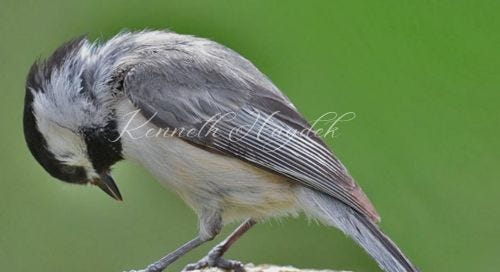February: The Black-Capped Chickadee
Super-cute and heartwarmingly curious, the black-capped chickadee is a suburb-friendly feeder bird that you should get to know, and because they don’t migrate, they may even pop into your backyard to grab some food during cold winter months.
How will you recognize the black-capped chickadee when it is in your neighborhood? Their most obvious feature accompanies their name: a black cap on its head that masks its eyes, with a black bib under its stout bill. They have white cheeks, soft gray backs and wings, tan sides, white bellies, and notched tail feathers. The black-capped chickadee’s large round head, short neck, and fluffy ball-like body make it disarmingly approachable, and indeed, black-capped chickadees seem to like humans as much as humans like them—even taking food from humans at close range.
In the spring, summer, and fall months, 80 – 90 percent of their diet is small insects and spiders. In winter months, their diet shifts to include more plant matter. At feeders, black-capped chickadees gravitate toward sunflower seeds, peanuts, and suet.
However, if they visit your feeder, don’t necessarily plan on them staying for a lengthy meal: black-capped chickadees like to take seeds and store them for later in various hiding places, most often crevices in tree bark. These small birds have remarkable memories. Each fall, their brains generate new neurons which enable them to remember thousands of food hiding places and also to adapt to social changes in their flocks.
In the fall and winter, black-capped chickadees form flocks, in which there is a hierarchy. More aggressive chickadees are dominant. Other birds, such as woodpeckers, warblers, and nuthatches, may join these flocks for protection and help locating food sources in sparse winter months. Since chickadee flocks often have non-chickadee guests with them, birder-lovers stay on the lookout for these flocks to catch glimpses of rarer migrants.
Like the dickcissel, “chickadee” is an onomatopoeic name, meaning that its name sounds similar to its call. Chickadees have language-like songs and calls, of which “chick-a-dee-dee-dee” is one of at least 15 different vocalizations that communicate information like food, territory, and alarm. In fact, the “chick-a-dee-dee-dee” call can indicate alarm, with the number of “dees” seeming to indicate the level of alert; a high-pitch see from a black-capped chickadee raises top alarm. This call is so effective at raising alarm, that other birds who hear it will heed that there is danger nearby. The “chick-a-dee” call can also be an “all-clear” signal.
Mid-winter, males, and occasionally females, will begin singing, most commonly a sweet “fee-bee” whistle. When winter turns into spring, chickadee pairs will leave the flock. Females will find a decayed branch, abandoned woodpecker hole, or man-made nesting box for a nest. The monogamous couple has just one brood per season, of six to eight eggs. The offspring will join other flocks apart from their parents.
Black-capped chickadees are found year-round in the northern half of the contiguous U.S. and the southern half of Canada, as well as southern portions of Alaska. Like our friend the ruby-throated hummingbird, black-capped chickadees brave cold temperatures by going into a state of controlled hypothermia so they don’t spend all their energy trying to keep warm. So, if you live in the black-capped chickadee range, in an area with deciduous trees, look and listen for these friendly visitors during all seasons.
Sources:
https://www.allaboutbirds.org/guide/Black-capped_Chickadee/overview
https://www.audubon.org/field-guide/bird/black-capped-chickadee
https://abcbirds.org/bird/black-capped-chickadee/
https://www.birdsandblooms.com/birding/bird-species/all-about-chickadees/



